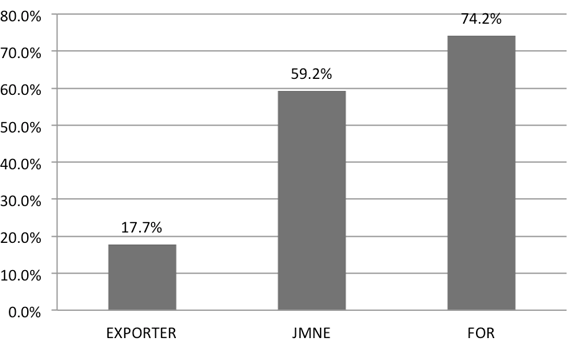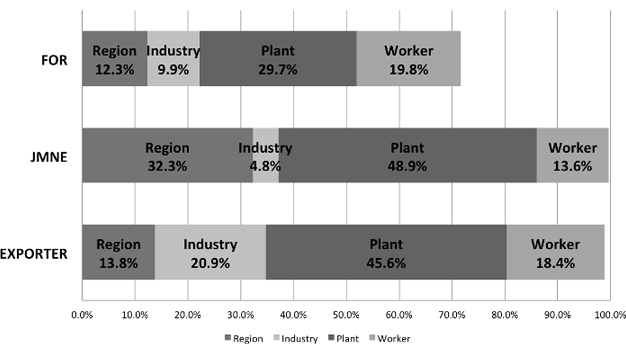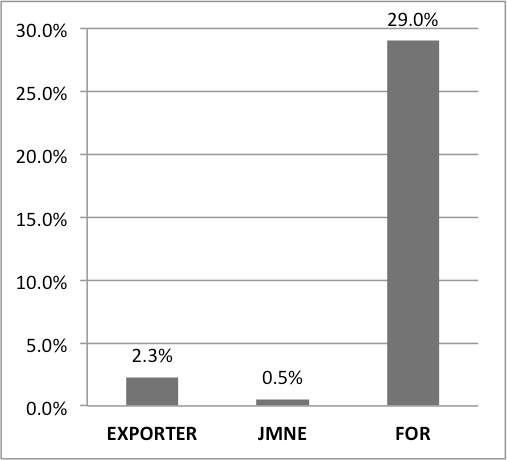Firms that engage in international markets tend to pay higher wages. This column provides new evidence on the wage premiums for exporters and multinational firms in Japan. The results show that wage premium for foreign-owned firms is far more important than that for exporters and domestically owned multinational firms.
Many previous empirical studies confirm that firms that engage in international markets tend to pay higher wages to their employees. Using linked employer-employee data, recent studies investigate whether the wage premiums for internationalised firms still exist after controlling for both firm and worker characteristics (Frias et al. 2009, Munch and Skaksen 2008, Schank et al. 2007, Schank et al. 2010, and Verhoogen 2008).
The reasons for the wage premiums have been explored theoretically. Based on the standard firm heterogeneity model of exports and foreign direct investment, recent theoretical studies consider that exporters and multinational firms pay higher wages than purely domestic firms because of intra-firm rent sharing (Helpman et al. 2010, Amiti and Davis 2012, Egger and Kreickemeier 2009, Egger and Kreickemeier 2013). These studies predict that exporters and multinational firms that obtain additional sales from foreign markets pay higher wages than purely domestic firms in an imperfect labour market.
Wage premiums: New evidence from Japan
In a new study (Tanaka 2015), I investigate the wage premiums for exporters, domestically-owned multinational firms, and foreign-owned multinational firms (foreign-owned firms), using linked employer-employee data from the Japanese manufacturing industry. The data are constructed from three official surveys: Basic Survey on Wage Structure (2012), Economic Census for Business Frame (2009), and Economic Census for Business Activity (2012). The linked employer-employee data have an advantage in that they can control for plant and worker characteristics as well as regional and industry factors. In addition, my data can distinguish domestically owned multinational firms from foreign-owned firms and jointly estimate wage premiums for exporters, domestically owned multinational firms, and foreign-owned firms. My study, therefore, can reveal which wage premium is the most important.
Figure 1 presents the wage premiums for local exporters without a foreign subsidiary (EXPORTER), Japanese multinational firms (JMNE), and foreign-owned firm (FOR), when their wages are compared with that of purely domestic firms, i.e. a non-exporting firms without a foreign subsidiary. It shows that, on average, local exporters tend to pay 17.7% higher in wages than purely domestic firms. Compared with the purely domestic firms, the average wage premiums for Japanese multinational firms and foreign-owned firms are 59.2% and 74.2%, respectively. This indicates that the average wages of multinational firms are more than one and a half times higher than that of purely domestic firms.

Decomposition of the wage premiums
Next, I examine what brings about such huge wage premiums. I estimate Mincer wage equations, using observable plant and worker characteristics as well as region and industry fixed effects as explanatory variables. Based on the estimation results, Figure 2 shows the extent to which region, industry, plant, and worker factors can explain the wage premiums for local exporters, Japanese multinational firms, and foreign-owned firms.
- The most important factor for the wage premiums is plant characteristics such as firm size. The evidence here is consistent with the well-known fact that larger firms tend to pay higher wages.
For Japanese multinational firms and local exporters, plant factor can explain about half of the wage premiums. Plant factor accounts for approximately 30% of the wage premiums for foreign-owned firms.
- For Japanese multinational firms and local exporters, the region and industry fixed effects explain more than 30% of the wage premiums.
It means that Japanese multinational firms and local exporters locate in high-wage regions and belong to high-wage industries. However, there is a difference between Japanese multinational firms and local exporters. The results show that for Japanese multinational firms, region fixed effect is much more important than industry fixed effect, while for local exporters, it is the vice versa. For foreign-owned firms, the region and industry fixed effects are also important and explain more than 20% of the wage premium.
- Worker characteristics such as experience and education also play an important role and account for approximately 13%-20% of the wage premiums.
For foreign-owned firms and local exporters, they explain about 20% of the wage premiums. For Japanese multinational firms, they explain 13.6% of the wage premiums. The results indicate that firms that engage in international market tend to employ more skilled workers than do purely domestic firms.

Unexplained wage premiums for foreign-owned firms
As shown in Figure 2, most of the wage premiums can be explained by observable plant and worker characteristics as well as region and industry fixed effects. These observable factors account for almost all wage premiums for Japanese multinational firms and local exporters, and for more than 70% of the wage premium for foreign-owned firms. In other words, the wage premiums for Japanese multinational firms and local exporters virtually disappear, whereas those for foreign-owned firms still exist, after controlling for the observable factors.
Figure 3 presents the unexplained wage premiums for local exporters, Japanese multinational firms, and foreign-owned firms. While the unexplained wage premiums for local exporters and Japanese multinational firms are close to zero, those for foreign-owned firms are large enough. The result implies that, on average, foreign-owned firms tend to pay 29% more in wages to an identical worker than purely domestic firms with similar characteristics in the same industry and in the same region.

Why do foreign-owned firms tend to pay such a large wage premium? There are several possible reasons, although this study cannot identify the exact reason. First of all, unobservable plant and worker characteristics can cause the unexplained wage premiums. As for unobservable plant characteristics, it is well known that traditional Japanese firms adopt a lifetime-employment system and pay a lump sum retirement allowance, while typical foreign-owned firms have fewer tendencies to adopt lifetime-employment systems. Such a difference in the employment system might require a foreign-owned firm to provide higher average wages.
As for unobservable worker characteristics, there is a possibility that foreign-owned firms tend to employ more skilled workers than purely domestic firms. My data do not include detailed information on the workers such as the university from which they graduated. The unexplained wage premiums for foreign firms might become smaller if those unobservable worker characteristics are controlled for.
Previous studies suggest other reasons for foreign-owned firms' wage premiums. They point out that the wage premiums can be attributed to compensation for different working conditions (Bernard and Sjoholm 2003, Fabbri et al. 2003, Lipsey and Sjoholm 2004) or learning opportunities (Gorg et al. 2007) in foreign firms.
Conclusion
My study jointly examines the wage premiums for local exporters, domestically owned multinational firms, and foreign-owned firms using Japanese linked employer-employee data. The results imply that the foreign-owned firms' wage premium is far more important than that for exporters and domestically owned multinational firms. In other words, this study suggests that nationality, rather than multinational status or exporting status, matters for wage premiums.
Author's note: This column is based on Tanaka (2015), an output of a project undertaken by the Research Institute of Economy, Trade and Industry (RIETI).
This article first appeared on www.VoxEU.org on January 17, 2016. Reproduced with permission.


